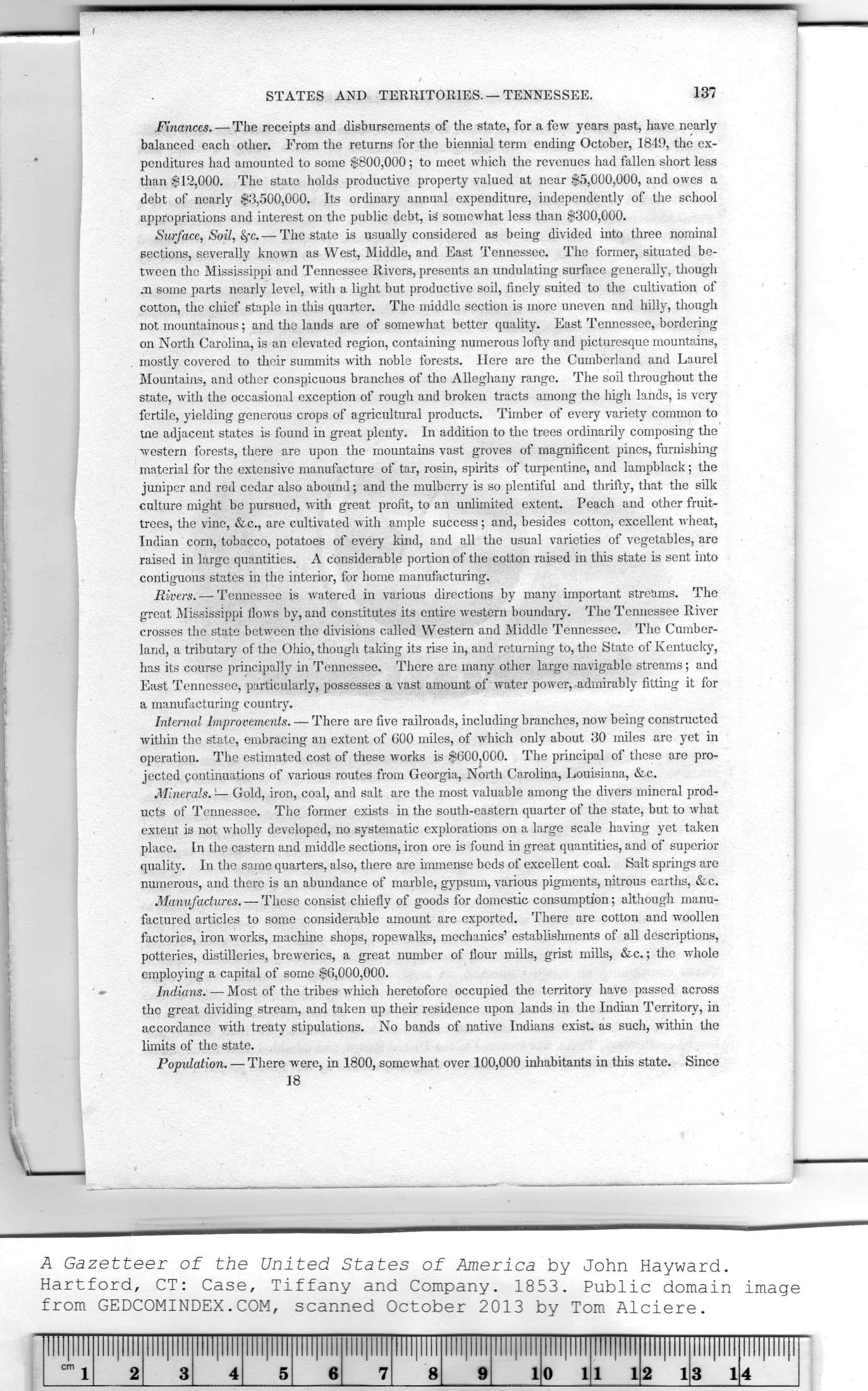|
|
Note: Ctrl and + increases the font size of the text below, Ctrl and - decreases it, and Ctrl and 0 resets it to default size.
STATES AND TERRITORIES. — TENNESSEE. 137
Finances. —■ The receipts and disbursements of the state, for a few years past, have nearly
balanced each other. From the returns for the biennial term ending October, 1849, the ex-
penditures had amounted to some $800,000 ; to meet which the revenues had fallen short less
than $12,000. The state holds productive property valued at near $5,000,000, and owes a
debt of nearly $3,500,000. Its ordinary annual expenditure, independently of the school
appropriations and interest on the public debt, is' somewhat less than $300,000.
Surface, Soil, fyc.— The state is usually considered as being divided into three nominal
sections, severally known as West, Middle, and East Tennessee. The former, situated be-
tween the Mississippi and Tennessee Rivers, presents an undulating surface generally, though
m some parts nearly level, with a light but productive soil, finely suited to the cultivation of
cotton, the chief staple in this quarter. The middle section is more uneven and hilly, though
not mountainous; and the lands are of somewhat better quality. East Tennessee, bordering
on North Carolina, is an elevated region, containing numerous lofty and picturesque mountains,
mostly covered to their summits with noble forests. Here are the Cumberland and Laurel
Mountains, and other conspicuous branches of the Alleghany range. The soil throughout the
state, with the occasional exception of rough and broken tracts among the high lands, is veiy
fertile, yielding generous crops of agricultural products. Timber of every variety common to
tne adjacent states is found in great plenty. In addition to the trees ordinarily composing the
western forests, there are upon the mountains vast groves of magnificent pines, furnishing
material for the extensive manufacture of tar, rosin, spirits of turpentine, and lampblack; the
juniper and red cedar also abound; and the mulberry is so plentiful and thrifty, that the silk
culture might be pursued, with great profit, to an unlimited extent. Peach and other fruit-
trees, the vine, &c., are cultivated with ample success; and, besides cotton, excellent wheat,
Indian corn, tobacco, potatoes of every kind, and all the usual varieties of vegetables, are
raised in large quantities. A considerable portion of the cotton raised in this state is sent into
contiguous states in the interior, for home manufacturing.
Rivers. — Tennessee is watered in various directions by many important streams. The
great Mississippi flows by, and constitutes its entire -western boundary. The Tennessee River
crosses the state between the divisions called Western and Middle Tennessee. The Cumber-
land, a tributary of the Ohio, though taking its rise in, and returning to, the State of Kentucky,
has its course principally in Tennessee. There are many other large navigable streams; and
East Tennessee, particularly, possesses a vast amount of water power, admirably fitting it for
a manufacturing country.
Internal Improvements. — There are five railroads, including branches, now being constructed
within the state, embracing an extent of 600 miles, of which only about 30 miles are yet in
operation. The estimated cost of these works is $600,000. The principal of these are pro-
jected continuations of various routes from Georgia, North Carolina, Louisiana, &c.
Minerals. — Gold, iron, coal, and salt are the most valuable among the divers mineral prod-
ucts of Tennessee. The former exists in the south-eastern quarter of the state, but to what
extent is not wholly developed, no systematic explorations on a large scale having yet taken
place. In the eastern and middle sections, iron ore is found in great quantities, and of superior
quality. In the same quarters, also, there are immense beds of excellent coal. Salt springs are
numerous, and there is an abundance of marble, gypsum, various pigments, nitrous earths, &c.
Manufactures. — These consist chiefly of goods for domestic consumption; although manu-
factured articles to some considerable amount are exported. There are cotton and woollen
factories, iron works, machine shops, ropewalks, mechanics' establishments of all descriptions,
potteries, distilleries, breweries, a great number of flour mills, grist mills, &c.; the whole
employing a capital of some $6,000,000.
Indians.—Most of the tribes which heretofore occupied the territory have passed across
the great dividing stream, and taken up their residence upon lands in the Indian Territory, in
accordance with treaty stipulations. No bands of native Indians exist, as such, within the
limits of the state.
Population. — There were, in 1800, somewhat over 100,000 inhabitants in this state. Since
18
A Gazetteer of the United States of America by John Hayward.
Hartford, CT: Case, Tiffany and Company. 1853. Public domain image
|
